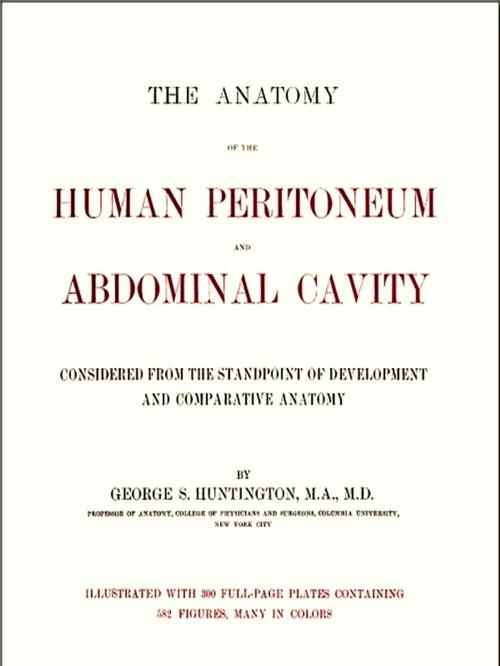The Anatomy of the Human Peritoneum and Abdominal Cavity
Considered from the Standpoint of Development and Comparative Anatomy
Nonfiction, Health & Well Being, Medical, Medical Science, Anatomy, Reference & Language, Reference, Guides & Handbooks| Author: | George. S. Huntington | ISBN: | 1230000156538 |
| Publisher: | VolumesOfValue | Publication: | July 31, 2013 |
| Imprint: | Language: | English |
| Author: | George. S. Huntington |
| ISBN: | 1230000156538 |
| Publisher: | VolumesOfValue |
| Publication: | July 31, 2013 |
| Imprint: | |
| Language: | English |
The Anatomy of the Human Peritoneum and Abdominal Cavity
Considered from the Standpoint of Development and Comparative Anatomy
This edition features
• illustrations
• a linked Table of Contents, Footnotes, and Index
CONTENTS
Introduction
Development of Vertebrate Ovum
Development of Cœlom and of Alimentary Cana
Development of Cloaca
Development and Divisions of the Peritoneum
Derivatives of Entodermal Intestinal Canal
Divisions of Alimentary Canal
Part I. Anatomy of the Peritoneum and Abdominal Cavity
Comparative Anatomy of Foregut and Stomach
Morphological Types of Stomach
Development of the Intestine
I. Intestinal Rotation and Definition of Adult Segments of the Intestinal Canal
Development of Aortal Arterial System
II. Demonstration of Intestinal Rotation in the Lower Mammalia
Peritoneal and Visceral Relations in the Infra-colic Compartment of the Abdominal Cavity in the Adult
Part II. Anatomy of the Peritoneum in the Supra-colic Compartment of the Abdomen
- Stomach and Dorsal Mesogastrium
a. Changes in Position of Stomach
b. Changes in Direction and Extent of Dorsal Mesogastrium
c. Development of Spleen and Pancreas in the Dorsal Mesogastrium and Changes in the Disposition of the Great Omentum - Development of Spleen
- Development of Pancreas
Development of Pancreas in Lower Vertebrates
Comparative Anatomy of Pancreas
Pyloric Cæca or Appendices
Peritoneal Relations of Pancreas
Comparison of Embryonal Stages during the Development of the Human Dorsal Mesogastrium, Spleen and Pancreas with the Permanent Adult Condition of the same Structures in Lower Mammalia - Spleen, Pancreas and Great Omentum of Cat
- Relation of Great Omentum to Transverse Colon, Transverse Mesocolon and Third Part of Duodenum
- Ventral Mesogastrium and Liver
I. A. Development of Liver
B. Comparative Anatomy of Liver
C. Development of Vascular System of Liver
Comparative Anatomy of the Hepatic Venous Circulation
II. Ventral Mesogastrium
Peritoneal Relations of Liver
Relation of Hepatic Peritoneum to the “Lesser Sac”
Caudal Boundary of Foramen of Winslow
Pancreatico-gastric Folds
Part III. Large and Small Intestine, Ileo-colic Junction and Cæcum
I. General Review of Morphology and Physiology of the Vertebrate Intestine
I. Midgut or Small Intestine
Intestinal Folds
Divisions of Small Intestine
Structure of Small Intestine - Secretory Apparatus
- Absorbing Apparatus
Valvulæ Conniventes
II. Endgut or Large Intestine
II. Serial Review of the Ileo-colic Junction and Connected Structures in Vertebrates
I. Fishes
II. Amphibia
III. Reptilia
IV. Birds
V. Mammalia
Monotremata
Marsupalia
Edentata
Sirenia
Cetacea
Ungulata
Rodentia
Carnivora
Cheiroptera
Insectivora
Primates
III. Phylogeny of the Types of Ileo-colic Junction and Cæcum in the Vertebrate Series - Symmetrical Form of Ileo-colic Junction; Mid- and End-gut in Direct Linear Continuity
- Asymmetrical Development of a Single Cæcal Pouch, lateral to the Ileo-colic Junction, Mid- and End-gut Preserving their Linear Continuity
- Rectangular Ileo-colic Junction, with Direct Linear Continuity of Cæcum and Colon
IV. Structure of Cæcal Apparatus and Specialized Morphological Characters of Colon in Rodents and Ungulates - Cæcum Proper
- Structural Modifications of Proximal Segment of Colon analogous in their Functional Significance to the Cæcal Apparatus
V. Cæcal Apparatus and Colon in Hyrax.
Part IV. Morphology of the Human Cæcum and Vermiform Appendix
I. Development of the Cæcum and Appendix
II. Changes in the Position of the Cæcum and Appendix during normal Development, depending upon the Rotation of the Intestine and the subsequent Descent of the Cæcum
III. Variations of Adult Cæcum and Appendix
A. Shape of Cæcum and Origin of Appendix. Types and Variations of Adult Cæcum and Appendix
B. Position and Peritoneal Relations of Appendix
C. Ileo-Cæcal Folds and Fossæ
The Anatomy of the Human Peritoneum and Abdominal Cavity
Considered from the Standpoint of Development and Comparative Anatomy
This edition features
• illustrations
• a linked Table of Contents, Footnotes, and Index
CONTENTS
Introduction
Development of Vertebrate Ovum
Development of Cœlom and of Alimentary Cana
Development of Cloaca
Development and Divisions of the Peritoneum
Derivatives of Entodermal Intestinal Canal
Divisions of Alimentary Canal
Part I. Anatomy of the Peritoneum and Abdominal Cavity
Comparative Anatomy of Foregut and Stomach
Morphological Types of Stomach
Development of the Intestine
I. Intestinal Rotation and Definition of Adult Segments of the Intestinal Canal
Development of Aortal Arterial System
II. Demonstration of Intestinal Rotation in the Lower Mammalia
Peritoneal and Visceral Relations in the Infra-colic Compartment of the Abdominal Cavity in the Adult
Part II. Anatomy of the Peritoneum in the Supra-colic Compartment of the Abdomen
- Stomach and Dorsal Mesogastrium
a. Changes in Position of Stomach
b. Changes in Direction and Extent of Dorsal Mesogastrium
c. Development of Spleen and Pancreas in the Dorsal Mesogastrium and Changes in the Disposition of the Great Omentum - Development of Spleen
- Development of Pancreas
Development of Pancreas in Lower Vertebrates
Comparative Anatomy of Pancreas
Pyloric Cæca or Appendices
Peritoneal Relations of Pancreas
Comparison of Embryonal Stages during the Development of the Human Dorsal Mesogastrium, Spleen and Pancreas with the Permanent Adult Condition of the same Structures in Lower Mammalia - Spleen, Pancreas and Great Omentum of Cat
- Relation of Great Omentum to Transverse Colon, Transverse Mesocolon and Third Part of Duodenum
- Ventral Mesogastrium and Liver
I. A. Development of Liver
B. Comparative Anatomy of Liver
C. Development of Vascular System of Liver
Comparative Anatomy of the Hepatic Venous Circulation
II. Ventral Mesogastrium
Peritoneal Relations of Liver
Relation of Hepatic Peritoneum to the “Lesser Sac”
Caudal Boundary of Foramen of Winslow
Pancreatico-gastric Folds
Part III. Large and Small Intestine, Ileo-colic Junction and Cæcum
I. General Review of Morphology and Physiology of the Vertebrate Intestine
I. Midgut or Small Intestine
Intestinal Folds
Divisions of Small Intestine
Structure of Small Intestine - Secretory Apparatus
- Absorbing Apparatus
Valvulæ Conniventes
II. Endgut or Large Intestine
II. Serial Review of the Ileo-colic Junction and Connected Structures in Vertebrates
I. Fishes
II. Amphibia
III. Reptilia
IV. Birds
V. Mammalia
Monotremata
Marsupalia
Edentata
Sirenia
Cetacea
Ungulata
Rodentia
Carnivora
Cheiroptera
Insectivora
Primates
III. Phylogeny of the Types of Ileo-colic Junction and Cæcum in the Vertebrate Series - Symmetrical Form of Ileo-colic Junction; Mid- and End-gut in Direct Linear Continuity
- Asymmetrical Development of a Single Cæcal Pouch, lateral to the Ileo-colic Junction, Mid- and End-gut Preserving their Linear Continuity
- Rectangular Ileo-colic Junction, with Direct Linear Continuity of Cæcum and Colon
IV. Structure of Cæcal Apparatus and Specialized Morphological Characters of Colon in Rodents and Ungulates - Cæcum Proper
- Structural Modifications of Proximal Segment of Colon analogous in their Functional Significance to the Cæcal Apparatus
V. Cæcal Apparatus and Colon in Hyrax.
Part IV. Morphology of the Human Cæcum and Vermiform Appendix
I. Development of the Cæcum and Appendix
II. Changes in the Position of the Cæcum and Appendix during normal Development, depending upon the Rotation of the Intestine and the subsequent Descent of the Cæcum
III. Variations of Adult Cæcum and Appendix
A. Shape of Cæcum and Origin of Appendix. Types and Variations of Adult Cæcum and Appendix
B. Position and Peritoneal Relations of Appendix
C. Ileo-Cæcal Folds and Fossæ










![Cover of the book Letters from Port Royal Written at the Time of the Civil War [1862-1868] by George. S. Huntington](https://www.kuoky.com/images/2013/july/300x300/1230000148155-Zl2P_300x.jpg)




